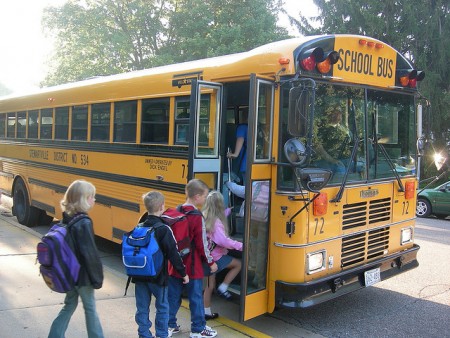Back to School Safety Tips for Drivers
September 6, 2016

School is back in session, meaning more students walking, biking, and taking the bus in Redmond.
Be extra vigilant in school zones and residential neighborhoods. Drive slowly, stay alert, and exercise a little extra care and caution for our student's safety.
Sharing the Road with School Buses
If you're driving behind a bus, allow a greater following distance than if you were driving behind a car. It will give you more time to stop once the yellow lights start flashing. It is illegal to pass a school bus that is stopped to load or unload children.
- Never pass a bus from behind – or from either direction if you're on an undivided road – if it is stopped to load or unload children
- If the yellow or red lights are flashing and the stop arm is extended, traffic must stop
- The area 10 feet around a school bus is the most dangerous for children; stop far enough back to allow them space to safely enter and exit the bus
- Be alert; children often are unpredictable, and they tend to ignore hazards and take risks
Sharing the Road with Walking Students
A few precautions go a long way toward keeping children safe:
- Don't block the crosswalk when stopped at a red light or waiting to make a turn, forcing pedestrians to go around you; this could put them in the path of moving traffic
- In a school zone when flashers are blinking, stop and yield to pedestrians crossing the crosswalk or intersection
- Always stop for a school patrol officer or crossing guard holding up a stop sign
- Take extra care to look out for children in school zones, near playgrounds and parks, and in all residential areas
- Don't honk or rev your engine to scare a pedestrian, even if you have the right of way
- Never pass a vehicle stopped for pedestrians
- Always use extreme caution to avoid striking pedestrians wherever they may be, no matter who has the right of way
Sharing the Road with Bicyclists
Children riding bikes create special problems for drivers because usually they are not able to properly determine traffic conditions. The most common cause of collision is a driver turning left in front of a bicyclist.
- When passing a bicyclist, proceed in the same direction slowly, and leave 3 feet between your car and the cyclist
- When turning left and a bicyclist is approaching in the opposite direction, wait for the rider to pass
- If you're turning right and a bicyclists is approaching from behind on the right, let the rider go through the intersection first, and always use your turn signals
- Watch for bike riders turning in front of you without looking or signaling; children especially have a tendency to do this
- Watch for bikes coming from driveways or behind parked cars
- Check side mirrors before opening your door